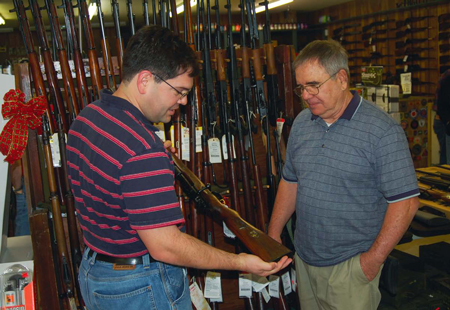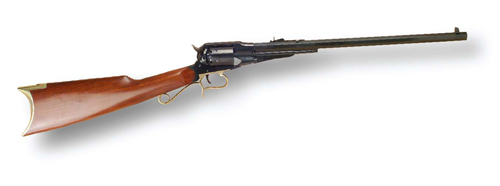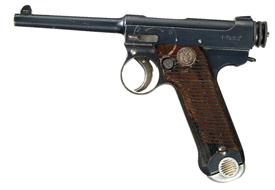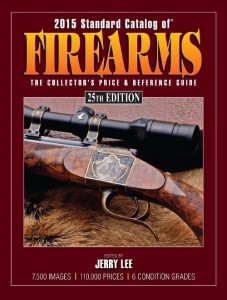
We collect because it is fun to learn about and possess these old firearms, whether they are the Guns that Won the West or the sidearm grandpa carried at Belleau Wood. Good collecting, the most satisfying kind of hunting and gathering or “accumulating,” becomes more than simple acquisition, more than decoration; it becomes a life-long passion that involves more than hiding artifacts in a safe.
The deeper we get into antique firearms, for instance, the more questions we ask: Did Remington manufacture .38 rimfi re Vest Pocket Pistols, its “Saw-Handle Deringer,” or were these simply mis-gauged .41s? And how many .30- and .32- caliber models were made? Are these versions quite rare or simply odd?

“Collecting, as opposed to gathering, can be an intellectual pursuit as well as a way to be with other people of a similar interest. In my experience, [fi shing] lure collectors, in particular are the some of more fun loving bunch of people I’ve encountered. How much fun is it to collect in front of your video screen? On the other hand, where else can you legally have this much fun and maybe make some money on your indulgences in the long run? Bottom line: collect what you really like and wait on those boomers to show up about the time you want to buy a house in Montana, but don’t quit the hobby just because it’s hard to find a five dollar Heddon.” – Michael Echols, originally written in 1998 and since updated for Gabby Talkington’s www.antiquelures.com. Used with permission.)
It is a challenge to dig into the unknown. There are so many peculiar and unanswered questions in every facet of firearms as to boggle the mind, and trying to decipher these puzzles keeps us on a learning curve when our human brains, by some medical and sociological accounts, have long since fossilized. Does it matter to the human race whether Remington manufactured .38 rimfire Deringers?
Probably not, but it may matter to us, personally. The mental stimulation of learning about any technology such as guns – the arguing, debating and researching – is sufficient reason, quite apart from actually owning them, to collect.
It is really no different than a medieval monk laboriously transcribing an ancient parchment scroll. It is brain health. But actually owning the old guns, turning them over in one’s gloved hands, poring over them with a magnifying glass is also important.
There is a story about an old duck hunter who has taken his grandson into the marsh. The old man calls and the cold wind blows and the boy shivers. Finally, the ducks swoop in and the old man points out the mallards and the blue wing teal and shows the boy how to tell them apart from the wood ducks, the drakes from the hens, and coaches him about lead, but the old man does not shoot.
As the next flight swings around the decoys, the boy does not raise his gun to shoot, either. “Why didn’t you shoot?” the old man asks and the boy says, “I just want to be like you, grandpa.” And the old man pats him on the back and says, “I’ve shot plenty of ducks in my time. Now it’s your turn. You have to shoot ‘em.”
It is the same way with antique firearms. Beyond the biofeedback, the hand-to-brain hypothesis suggests that it is the stimulation of our restless hands and fingers that encourages our brain to learn:
“You have to own them.” Learning about old guns is wonderful and some might say a sufficient reason to be interested. That coin has another side, however, and that is actually making a purchase; taking home your first gun. And that thrill – and it is a thrill – is absolutely necessary to fully participate in and enjoy this antique field, whether or not it is ultimately a meaningless activity and whether our kids follow in our collecting footsteps.
Investing vs. the True Collector
It was a myth, perhaps one that fans of Old West stories want to believe, but dime novelist Ned Buntline never had these guns built for the Earps…or what was left of the Earps after the fallout from the OK Corral incident. Legend has it that Buntline presented special order Colt revolvers with 12-inch barrels and detachable shoulder stocks to Wyatt Earp, Bat Masterson and other noted Old West celebrities. Based on this story, the long-barreled Peacemakers came to be called “Buntline Specials.” Uberti makes them now, with incredible 18-inch barrels, but are they really “reproductions?” Buntline wrote the sort of turn-of-the-century Dime Novel that popularized the gun as a method for settling arguments and made heroes – famous and infamous – out of many of the cutthroats, neer-do-wells and rascals who flooded west toward America’s frontier. (Courtesy Autry National Center)
It was a myth, perhaps one that fans of Old West stories want to believe, but dime novelist Ned Buntline never had these guns built for the Earps…or what was left of the Earps after the fallout from the OK Corral incident. Legend has it that Buntline presented special order Colt revolvers with 12-inch barrels and detachable shoulder stocks to Wyatt Earp, Bat Masterson and other noted Old West celebrities. Based on this story, the long-barreled Peacemakers came to be called “Buntline Specials.” Uberti makes them now, with incredible 18-inch barrels, but are they really “reproductions?” Buntline wrote the sort of turn-of-the-century Dime Novel that popularized the gun as a method for settling arguments and made heroes – famous and infamous – out of many of the cutthroats, neer-do-wells and rascals who flooded west toward America’s frontier. (Courtesy Autry National Center)
According to Gabby Talkington of AntiqueLures.com, “The person who gets into collecting because he or she enjoys it is going to come out ahead, no matter what happens to the market. If they have fun studying old lures or whatever, then when a barrel of oil reaches $200 and the bottom drops out of the stock and collectible markets, they won’t be hitting their head against the wall like they would if collecting was just some investment. If they’re collecting because its fun to fi nd and have this old stuff around and the prices go up…then that’s kind of a double bonus.
“There is the risk that the bottom [of the collector market] will fall out tomorrow. The collectible decoy prices fell. Gold coins fell. Baseball cards fell. Think about it again. You didn’t sell that lure for $1,000 last week…and the very next week the market crashes and we are back to the $5 lure! Don’t laugh, it could happen. It has happened before.
“In 1988-89 the prices went through the ceiling and crashed the next year as the rolling recession of the 1990- 93 period started. With the Asian and Russian economies crashing in 1998 [and ultimately rebounding] we may see the same results sooner than later.
“Collecting is a mind game. Without the perception, in your mind, that something has value then there is none. What is the intrinsic value of a wood fi shing lure? Well, we’re back to the $5 lure.” – Michael Echols, writing for Gabby Talkington’s www.antiquelures.com With permission.)
Perhaps it is the same in every collecting field. A group gets together for a beer and talk turns to “what Dad did in the war.” The next time they have a neighborhood Bar-B-Q someone brings an old Nazi battle pennant and soon, someone else brings the Luger that his father smuggled home from Germany. Then someone buys a book such as the annual Standard Catalog of Firearms or does an Internet search for “gun collecting” and a whole new pod of collectors springs to life.
The men and women in this hypothetical neighborhood group illustrate an excellent way to get started in collecting – start or become part of a group. One person’s interest feeds that of another and enthusiasm, stories, good purchases and even screw-ups become a commonly shared experience. A quiet competitiveness is naturally awakened within the group.
While joining a club or hanging out with other collectors is a great way to get started, there is really no “wrong” way to begin (unless it is to rush out and buy something impulsively). Nevertheless, most collectors, writers and gun experts suggest that to get involved in collecting with the objective to make money buying and selling guns as investments is close to the wrong way.
Becoming a “gun trader” involves an entirely different motivation and methodology, one that is strictly mercantile, commodity oriented. While collecting values tend to be stable to gradually increasing – after all, as Mark Twain is supposed to have quipped about land, they are not making any more Model 1, First Type Smith & Wes- son .22s, for example (Or are they? Does one count a reproduction?) – those same values can be volatile and swings in the marketplace are as notorious as swings in the stock market. (Former Hoyt-USA president Joe Johnston recalls that the archery company got a terrific, although temporary boost when Sylvester Stallone used their product in his first Rambo movie in 1882.)
On the one hand, Nevada Colt collector Ed Cox warns, nothing is assured in the world of collecting. The generation of kids who grew up playing cowboys and Indians, the ones who are especially in love with cowboy action shooting and collecting antique Colt SAAs, are getting “along in years” now and whether the next generation wants these old guns is anyone’s guess. (When members of the next generation arrive at their 50s, they may collect vintage iPods!)
But on the other hand Cox notes that, “If I had put my dollar in a savings account in the bank, it would never be worth $1,300. By buying the antique gun, though, it would surely go up in value. If I’d bought an antique gun when I was a kid the value would be $1,800- $2,500 now.”
Florida’s Norm Flayderman believes that gun collecting has so far been isolated from dramatic market swings because it has not attracted hordes of “investors,” people hoping literally to get rich quick, the Warren Buffets trying to corner the market on silver, for instance. What has given the antique or collectible gun market its continuing viability is that collectors know the guns and have an interest in them other than strictly their monetary value.
Thus, as the economy swings, the gun market tends to remain steady to increasing – again, because the field is saturated with true collectors rather than investors who, Flayderman notes, “purchase only for the sake of financial gain with no appreciation for the arms themselves.” Previous Page Next Page
NM Collector SoftwareThis gun collecting series brought to you by NM Collector Software.
The Six Rules Of Smart Collecting

After World War II, there was an awakening to the quality of Japanese arms when returning soldiers brought thousands of them home as souvenirs. Today, they are highly collectible. This Type-14 Nambu was manufactured at the Nagoya Army Arsenal in February 1927. Rock Island Auction valued it between $950 and $1,100 (Lot 169) and said that “while the magazine is nickel and mismatched, the gun is in excellent condition. It retains approximately 90 percent original blue finish and 75 percent straw colors. The grips are very good with small chip out of left grip on bottom, the usual gouge from the safety lever and minor handling marks….the right side grip screw is locked up and the head is slightly marred.”
1) Read and Learn. The rules of satisfying collecting are perhaps everywhere the same. They begin with identifying your interest and – before collecting any firearms – collecting information, building a storehouse of knowledge. If you are enticed into the field by the romance of the American Frontier era and enjoy looking at old Colt firearms, your fi rst purchase might be Doc O’Meara’s book on the Colt SAA.2 O’Meara’s book will both inspire you to collect and alert you to some of the nuances of the field, Bisleys to Buntlines.
The more you read and learn, the easier it will be to narrow your interest and objective when you get that itch to write out a check. And the more secure you will feel when you return home without that sulkingly familiar “buyer’s remorse.” Every bookstore has an outdoor section that contains a sample of gun books, but the best references for these invaluable collector’s aids can be found online with a minimum of searching.
2) Find People with Similar Interests. A second rule of good collecting is to affi liate with others and learn from them…or allow them to learn from you. While any group can exhibit a “flock mentality” and carry you over the edge to a disastrous purchase (the lemming mentality of group-think), there is strength in numbers. Within
a group, the new collector can find a mentor and can, in turn, become a mentor. There are quite a few gun-collecting associations and we provide a brief listing of national groups in an Appendix at the end of this book.
3) Attend Gun Shows. At an early stage, it is a wonderful use of your time to visit local gun shows. Unless they are so designated, local shows will not have many antique firearms, although many curio and relic (C&R) guns and a ton of reproductions will be on view and on sale. Gun shows are a great place to make contacts, to pick up business cards of men and women who may take time with a newcomer, to learn about organizations that provide contacts and information.
They are not necessarily good places to make a purchase for a collection, however, because there is simply not time – and there are rarely facilities – to study and to thoroughly examine a gun. For that, one needs reference books, a good magnifying glass, good light and some peace and quiet, time without interruption to look and
think; time to just sit and stare at the gun….
4) Avoid Impulse Buys. The fourth rule of good collecting is to avoid the rush to make a purchase. Everyone is, on occasion, struck with the craving to buy now, as in “right now.” It is a strain of impatience that runs deep in the male species, men generally possessing the pro-buying, anti-shopping gene. Generally speaking, if something looks too good to be true, it probably is. Today, the field of American firearms holds many questions, but few surprises.
Still, every serious gun collector has a story about making an impulse decision to buy a firearm without thoroughly examining it or questioning its owner. It happens when one is distracted and can happen to an expert as well as a newbie. The field is littered – some say heavily – with altered and even downright faked firearms, and so when the impulse rises to make a snap decision that will cost hundreds or perhaps thousands of dollars, your best course of action is to walk away.
Ninety-nine percent of the time this will be the correct long-term decision.
5) Make a Test Purchase. While avoiding the impulse buy, it ultimately becomes important to buy…something. As a youngster I wanted a telescope to look at the moon and stars. My father insisted that I read about telescopes first, learn the principles by which the mirrors worked and then once I knew what I was talking about, he
said, we would buy a great telescope.
Learning somewhat in a vacuum with only pictures and nothing to actually handle, manipulate, enjoy, I found words about objectives lenses and diopters and image stabilization to be terribly frustrating. I never got a telescope and eventually lost interest. I did not want an expensive motor-driven refracting telescope anyway…just something to play around with. The recollection of that experience, and others since then, have led me to believe that nothing quite beats handling the real thing to stimulate interest. You must have something to “play around with.” Only by investing in more than moving our eyes and perhaps our brain, only by making a real purchase can we extend the learning and enjoying experience.
Perhaps it is a version of the “build it and they will come” philosophy. Your fi rst purchase does not have to be expensive; it probably should not be expensive, in fact, but it has to excite you. Stimulate you to want to learn more, see more and, yes, possess more. (Hint: For your first purchase, buy down in desirability, but up in quality or grade.)
6) Build Relationships. Finally, when one has read and looked at pictures as much as one can stand, when one has narrowed one’s interest and visited gun shows and even made an initial “test purchase,” it is time to establish a relationship with a seller. One of the best ways to avoid being stuck with a turkey is to know the person
who is selling to you; know where they will be two weeks after your check has cleared. By developing a long term relationship with a seller – whether it is an auction house or a private gun trader, 3 one begins to develop trust.
A serious caution is in order here, however. Even though you may be collecting for fun, money is changing hands and that makes some aspect of collecting a business. If it isn’t a business for you, it almost certainly will be for the person who is selling to you and in a business relationship you must, in the words of Ronald Regan, “Trust, but verify.” The first time your new best friend approaches with a Confederate Colt, show your interest and ask for the paperwork, the provenance, and for any independent evaluations that might be reasonable. If the seller is legitimate and the product is legitimate as well, your questions and requests for independent authentication will not be offensive. You might also ask for a written, 90-day money-back guarantee. If you are afraid to speak up, you lose.
![]() This gun collecting series brought to you by NM Collector Software.
This gun collecting series brought to you by NM Collector Software.
2015 Standard Catalog of Firearms, 25th Edition
The 2015 Standard Catalog of Firearms, 25th Edition is the preferred desk reference guide to the realm of antique, vintage, and modern firearms from around the world, and is now in its Silver Anniversary, 25th edition with more than 26,000 listings of collectible and modern firearms. This industry-leading reference on firearms valuation and pricing has everything you need, whether you’re looking to buy, sell, or collect firearms.


![Best Concealed Carry Guns In 2025 [Field Tested] Wilson Combat EDC X9S 1](https://gundigest.com/wp-content/uploads/Wilson-Combat-EDC-X9S-1-324x160.jpg)


![Best 9mm Carbine: Affordable PCCs [Tested] Ruger Carbine Shooting](https://gundigest.com/wp-content/uploads/Ruger-Carbine-Shooting-100x70.jpg)
![Best AR-15: Top Options Available Today [Field Tested] Harrington and Richardson PSA XM177E2 feature](https://gundigest.com/wp-content/uploads/Harrington-and-Richardson-PSA-XM177E2-feature-100x70.jpg)
